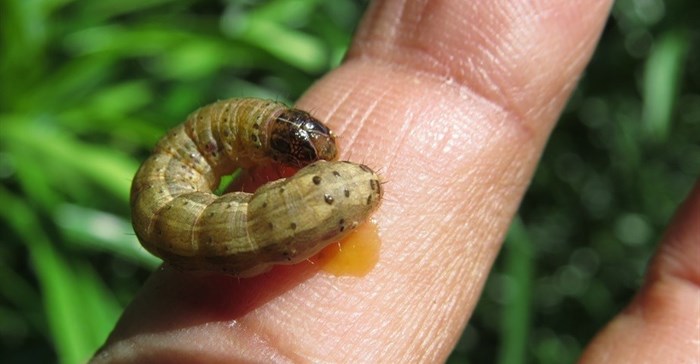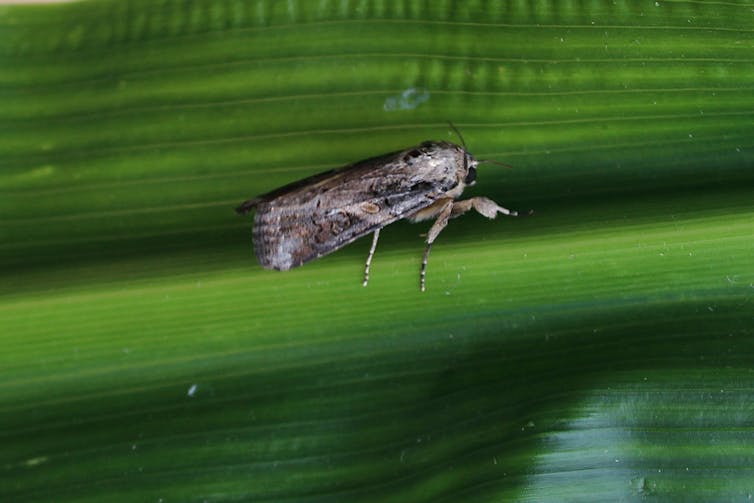Exploring the best tactics to combat Fall armyworm outbreaks in Africa

The Fall armyworm’s lifespan, from egg to larva to moth, lasts between one to three months. It’s during the larval stage that it does the most crop damage. Controlling them is a challenge because they reproduce fast and in large numbers, can migrate great distances, hide within growing leaves and have been reported to resist several pesticides. Emergency responses by the affected countries have been based on the use of pesticides but in most cases, this has proven costly and not very effective.

Adult male moth.
Sevgan Subramanian
Various tactics – both old and new – are being tested to try and control the Fall armyworm in Africa. These include the use of inter-cropping technology, natural enemies, early warning systems and use of biopesticides.
To combat the voracious pest, and prevent the huge losses, policymakers, extension agencies and growers could learn from the experiences of farmers in the Americas, and adapt the same to suit the smallholder African production system. This knowledge must be shared with farmers and agricultural officers. And any policy developed must involve local and international stakeholders before being rolled out.
Stopping the outbreak
The pest, an alien from the Americas, was first reported in Africa in 2016. Starting in the São Tomé and Príncipe islands and Nigeria, in just two years it spread to over 38 African countries.
The speed with which they spread could be due to a few factors. Firstly, female armyworms produce a huge number of eggs (between 50 - 200 eggs per batch), and can have up to 10 batches within her lifespan. Secondly, the moths are carried by the wind across vast distances. Some have been known to travel up to 1,000km. Thirdly, numbers aren’t being reduced by their natural enemies which means they can multiply uninhibited.
All these factors are crucial to keep in mind when managing an outbreak.
Pesticides: In sub-Saharan Africa, most food is produced by smallholder farmers. When they try to control an outbreak they will often use pesticides as these are believed to instantly suppress the pest. The use of chemical pesticides seems to be the most common practice that is currently heavily supported by the government.
But pesticides can be harmful, particularly to the environment as they affect non-targeted organisms, like bees.
Though often overlooked, there are other, more natural approaches which have proven effective.
Push-pull and other intercropping technology: In this approach crops are grown alongside one another. Some act as a deterrent to insect pests and weeds. The system has reduced pest infestation drastically. This technology has the additional benefit of providing high-quality fodder for livestock and improving yields and soil fertility.
For example, when a “trap” crop (such as Napier grass) is planted around maize rows, it attracts stemborer moths to lay eggs on it. But, because the grass isn’t nutritious, very few stem borer larvae will survive.
In the case of fall armyworm, this has proven effective when maize is inter-cropped with drought-tolerant Greenleaf desmodium and planting Brachiaria as a border crop around this intercrop. When compared to mono-crop areas, data collected from over 250 farmers, who adopted this technology in drier areas of Kenya, Uganda and Tanzania, showed a reduction of 82.7% in the average number of larvae per plant and 86.7% in plant damage per plot. Intercropping maize with edible legumes can also result in up to 40% reduction in armyworm incidence and damage.
On the basis of these multiple benefits, the International Centre of Insect Physiology and Ecology and partners are rolling out the approach in sub-Saharan Africa.
Early warning, surveillance and monitoring systems: Surveillance and monitoring are crucial to managing an outbreak. They ensure that identification happens very early, before a full outbreak, and allows for proper response management.
Pheromone traps, which use the smell of a female armyworm to attract a male, can be a very useful surveillance tool. Judging by the number of moths captured, an infestation can be quickly recognised. These types of surveillance systems are already being demonstrated within some communities. The traps can also be used for mass trappings to reduce the numbers.
Biocontrol: several ecologically sustainable biocontrol solutions are available to farmers. The release of natural enemies is one of them. Parasitic wasps for example can provide (up to 70%) control for Fall armyworm by laying their eggs on or inside the Fall armyworm eggs or larvae.
Scientists at International Centre of Insect Physiology and Ecology have also identified locally available natural enemies, such as the wasp Cotesia icipe, which has proven effective against the armyworm larvae in the lab.
If these natural enemies are reared in bulk, they can be released in huge numbers in affected fields and conserved. As they multiply in the fields, they can control the pest as they feed on the pest’s larvae.
Biopesticides: These are a fungal, viral or bacteria based product which kill the Fall army worm. Examples include the fungi-like Metarhizium anisopliae or bacteria-based Bacillus thuringiensis that have proven effective against Fall armyworm and have been used to control it in the US and Brazil.
There are also botanical pesticides which act as both deterrent and toxins. These can prevent the caterpillar from feeding on the crop but also interfere with its ability to grow.
![]() Efforts to control Fall armyworm by African governments could draw on the lessons of all these interventions which have been used in the Americas but also trialled in Africa. Obviously, local adaptations will need to be made. But the Fall armyworm will remain in Africa for a long time unless concerted action is taken, drawing on the various methods from America and those available in Africa.
Efforts to control Fall armyworm by African governments could draw on the lessons of all these interventions which have been used in the Americas but also trialled in Africa. Obviously, local adaptations will need to be made. But the Fall armyworm will remain in Africa for a long time unless concerted action is taken, drawing on the various methods from America and those available in Africa.
This article was originally published on The Conversation. Read the original article.
Source: The Conversation Africa

The Conversation Africa is an independent source of news and views from the academic and research community. Its aim is to promote better understanding of current affairs and complex issues, and allow for a better quality of public discourse and conversation.
Go to: https://theconversation.com/africa










